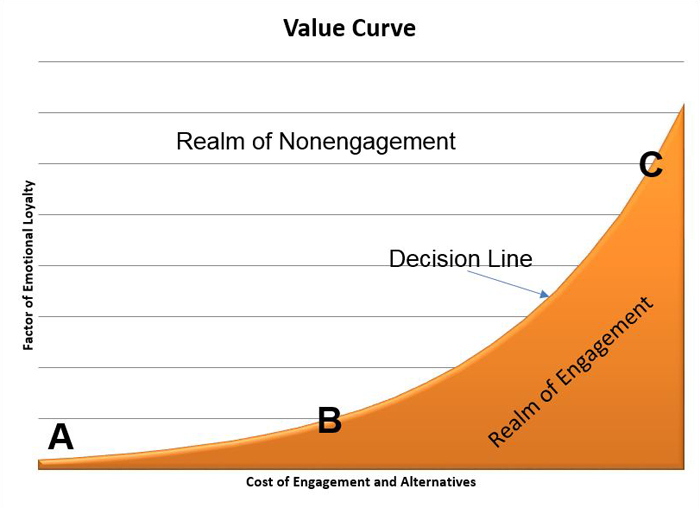Michael Barbagallo
Michael Barbagallo is senior manager of member services at the National Council of Teachers of Mathematics.

Associations must go beyond economic benefits to keep members engaged. Instead, by engaging members on an emotional level, they'll find they can increase member value exponentially.
You and your team walk into a restaurant for dinner. The food is very good. But, the service is outstanding. Your server, among many other services, makes suggestions based on a team member's dietetic restrictions and he entertains a child at the next table.
The next evening you visit another restaurant. The food is excellent, probably the best you have ever tasted, but the service is poor. You have to wait to get a table, and the server acts as if he is doing you a favor. Furthermore, you have to ask for more water several times.
Both meals cost about the same. Which restaurant do you visit a second time? Most likely the first one.
Over the past two or three decades, for-profit companies have seen a decline in automatic brand loyalty. Their new reality is customer loyalty based more on experience than product.
Associations are now facing a similar challenge and a significant shift away from automatic engagement. Associations now have to prove their value at each renewal cycle.
For-profit companies and associations have different goals and functions. However, customers and members are both asking "What value do I get?" with every engagement, meaning that customer loyalty and member engagement are the same thing.
There are many definitions of customer loyalty and member engagement. But, there are two distinct bases: economic and emotional.
Economic loyalty is when customers feel they have to stay. Emotional loyalty is when a customer wants to stay.
Economic loyalty is a cost-benefit analysis members make when engaging. If a member feels the benefits of engaging outweigh the costs, they will continue to engage. When the costs outweigh the benefits, the member seeks alternatives.
Economic loyalty is easy to create. Discounts, affiliate programs, and special members-only offers are clear examples of economic loyalty initiatives.
Emotional loyalty is when members feel a passion and they find the association trustworthy. If a member trusts that the association has their best interest in mind, they can connect at a personal level and are more likely to overlook price increases, alternatives, or poor service. Emotional loyalty is difficult to achieve because each person has a unique trust threshold.
Loyalty and engagement are important for the health of an association. Not only does loyalty encourage engagement, but it also can bring in new members through referrals. Both economic loyalty and emotional loyalty have their places. But, for associations to encourage deeper engagement, they should strive to build emotional loyalty.
Member engagement can be expressed as a function of economic and emotional loyalty:
VM≥∑C+∑A
For engagement to occur, the value a member receives (V), raised to power of the emotional connection (M), must be greater than or equal to the tangible and intangible costs of engagement (∑C) plus cost of using alternatives (∑A).
The graph of the engagement function looks like the graph below, where the cost of engagement and alternatives are the X axis and the value of engagement is the Y axis. Engagement occurs below the curve.

When the curve is shallow, like between points A and B, emotional loyalty is low and economic loyalty is the prevailing factor. However, as the emotional-based loyalty strengthens, such as between points B and C, economics have a decreasing impact on value. Furthermore, there is a point where the emotional connection is strong enough (point C) that economics has little role in a member's decision to engage.
Member engagement thrives when members want to engage, as opposed to feeling they have to engage. Increasing value (V) through emotional-based engagement (M) is not a program or product or even a human-to-human interaction. Increasing M is a process that requires multiple positive interactions over time.
Moreover, M is influenced positively, negatively, or neither by how the member feels after each interaction. In the 2014 American Express Customer Service Barometer [PDF], 74 percent of US consumers said they have spent more with a company because of a history of positive customer service experiences. This trend spans across all generations. While the study focuses on for-profit companies, parallels can be made because customer loyalty and member engagement are the same thing.
A key point in increasing M is realizing organizations are the total sum of their products, services, policies, procedures, and people. When a member interacts with an association, it involves more than one "touch point." A touch point is any time a member engages with a product, service, policy, procedure, and person. The outcomes of the interactions impact the emotional loyalty members feels toward associations; satisfying outcomes increase M, unsatisfactory outcome decease M. And, as M increases, the more likely members will continue to engage.
ValueM ≥ Cost of Engagement + Cost of Alternatives
For members to continue to engage, the value of engagement, raised to the power of emotional engagement (M), must be equal to or greater than the cost of engagement plus the cost of alternatives. Programs, such as discounted or free memberships, set a baseline value and may also increase value (V) incrementally. These programs are effective as part of an overall engagement campaign that incorporates short-term economic rewards with quality relationship building. But, long-term impact is limited.
Associations can increase the value of engagement by strengthening the relationship with their members as expressed in M. The stronger the relationship, the higher M becomes, which in turn increases V and increases the possibility of engagement.
For-profit companies know that customer loyalty is a key factor to their bottom lines. The stronger their relationship with customers, the more likely the customer will return. And they figured out that strengthening relationships is a process, not a one-time engagement. The first restaurateur in the opening example understood how M affected V and made experience primary and product secondary.
The effort associations make to strengthen relationships with members has a direct correlation to engagement. Associations have an advantage, as many members start with a small emotional-attachment. The role of the association is to build that kernel so that the value of engagement is greater than its costs.